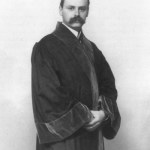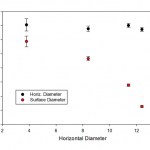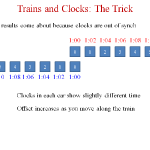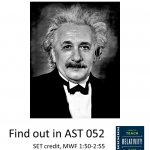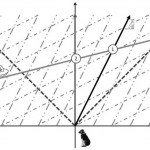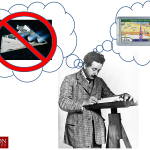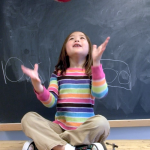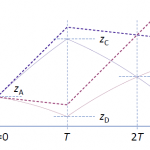Relativity
A long-ish stretch of time, but I was basically offline for a bunch of that because I needed to finish a chapter I was asked to contribute to an academic book. So there are only four physics posts from Forbes to promote this time:
-- 'The Expanse' Is A Rare Sci-Fi Show That Gets Simulated Gravity Right: Another post on the SyFy adaptation of "James S. A. Corey"'s books, talking about a nifty bit of visual effects that nods at the Coriolis force you'd see on a rotating space station.
-- What Is The Quantum Pigeonhole Principle And Why Is It Weird?: A paper published in the Proceedings of the…
I've been slacking in my obligation to use this blog for self-promotion, but every now and then I remember, so here are two recent things where I was interviewed by other people:
-- I spoke on the phone to a reporter from Popular Mechanics who was writing a story about "radionics" and "wishing boxes," a particular variety of pseudoscience sometimes justified with references to quantum mechanics. The resulting story is now up, and quotes me:
It is hard to investigate the ethereal thinking around radionics, but physics is something that can be parsed. So I got in touch with Chad Orzel, a…
I forgot to do this last week, because I was busy preparing for SteelyPalooza on Saturday, but here are links to my recent physics posts over at Forbes:
-- What 'Ant-Man' Gets Wrong About The Real Quantum Realm: On the way home from the Schrödinger Sessions, I had some time to kill so I stopped to watch a summer blockbuster. The movie was enjoyable enough, thanks to charming performances from the key players, but the premise is dippy even for a comic-book movie. It does, however, provide a hook to talk about quantum physics, so...
-- Great Books For Non-Physicists Who Want To Understand…
There's a new Science Express paper on interfering clocks today, which is written up in Physics World, with comments from yours truly. The quote is from a much longer message I sent-- with no expectation that it would end up as anything other than a pull quote, I might add, but I thought the background would be helpful. Since I ended up doing a back-of-the-envelope estimate for that, though, I thought I would reproduce some of the reasoning here.
The basic proposal idea here is to do an atom interferometer inside a Ramsey interferometer for making an atomic clock. That is, before sending the…
As mentioned over the weekend, I gave a talk last week for UCALL, part of a series on "The Radical Early 20th Century." I talked about how relativity is often perceived as revolutionary, but isn't really, while Einstein's really revolutionary 1905 paper is often overlooked. And, having put the time into thinking about the subject, I turned the basic theme into a new blog post over at Forbes:
Albert Einstein is easily one of the most recognizable people in history, and everybody thinks they know why. He’s the guy who, in 1905, completely revolutionized physics, overthrowing the prior order…
It was nice and sunny this morning when I sat down at Starbucks to do some blogging, so I wrote a new Forbes post about the quantum physics that makes sunshine possible. This also brings in xkcd's take on the fundamental forces, and even a little bit of SteelyKid.
Sadly, it's now grey and dreary, but that's spring in New England for you. But if you'd like a small amount of quantum-mechanical sunshine, head on over to Forbes and check it out.
(When I launched the Advent Calendar of Science Stories series back in December, I had a few things in mind, but wasn’t sure I’d get through 24 days. In the end, I had more than enough material, and in fact didn’t end up using a few of my original ideas. So I’ll do a few additional posts, on an occasional basis, to use up a bit more of the leftover bits from Eureka: Discovering Your Inner Scientist…)
While we mostly think of science being done in comfortable institutes if not gleaming laboratories, one of the most impressive and inspiring things about science is that people can and do carry…
I exchanged a bunch of emails a week or two ago with a journalist who was working on a story involving the possibility of faster-than-light travel. He wanted me to check some statements about the relationship between FTL and causality. FTL creates problems for causality, because if you have an object moving faster than light, there will be pairs of observers who see events involving the FTL object happening in different orders, which means somebody will see an effect happen before its cause.
I talk about this is How to Teach Relativity to Your Dog using the example of a stationary dog, a…
A couple of times last week, I mentioned on Twitter that I was going to demonstrate relativity with toddler toys and string. This was an inspiration that hit late on Thursday, when I was trying to think of a better way to explain embedding diagrams (the technical term for those stretched-rubber-sheet pictures that everybody uses to illustrate general relativity).
Specifically, I was hearing a lot from students who didn't understand the point of what was supposed to be weird about those. So I was trying to think of how to do a demo, when I realized we could measure the change in geometry that…
I'm teaching a Gen Ed course on relativity this term, which means I'm spending the last few weeks of the term discussing black holes. Which, in turn, means there was no way I couldn't use that story about Kip Thorne calculating the appearance of a black hole for the movie. Especially since I have the students reading Thorne's book.
And that, in turn, meant I needed to see the movie. So we got a sitter for the kids Saturday night, and went to the local theater to check it out. And, you know, it's pretty much what it's advertised as: A very pretty giant SF movie, with all that implies, both…
It's baseball playoff time, so sport shows are full of one of the great mysteries of the season, exemplified by this .gif (from SBNation):
Raul Ibanez hitting a game-winning home run. GIF from SBNation.
No, not "Raul Ibanez, really?" but "How can he make the ball go that far?" After all, even very good outfielders are lucky to reach home plate with a throw from the warning track. Not even the hardest-throwing pitcher could stand at home plate and throw the ball into the second deck of a baseball stadium. Yet it's not uncommon for the ball to end up there after being hit by a bat. So, how…
My Gen Ed relativity course has mostly been me lecturing about stuff to this point, so on Wednesday I decided to shake things up a bit and convert a chapter of David Mermin's It's About Time. The idea was to get students up and moving around a bit, and actually making some measurements of stuff.
Mermin's scenario as adapted for class is this: you have two trains of six cars passing in opposite directions. Each car contains a narrow window through which the other train can be seen, a clock facing the window, and an observer with nothing better to do than note the readings of the clocks in the…
The new academic year starts this week-- first day of classes is Wednesday-- and I'm dealing with the usual chaos associated with the influx of a new class of students. Who now look to me only a tiny bit older than SteelyKid and the Pip in the above picture (and if you think that sharing that extremely cute photo is part of the motivation for this post, well, you're not wrong...).
This year, the madness of the new term is complicated by having been away for essentially all of August, and by the fact that I'm teaching an entirely new class this term: Astronomy 052: Relativity, Black Holes, and…
This coming fall term, I'll be teaching Astronomy 052, "Relativity, Black Holes, and Quasars," because the guy who has traditionally taught it (a radio astronomer who studies active galactic nuclei) has to do other courses instead. But I said "Well, hell, I've written a popular audience book explaining relativity. I can teach that." And since I get to make teaching assignments (the one and only positive feature of being department chair), well, I put myself down to teach it. Now, of course, I find myself thinking about ideas for that class, months in advance, when I ought to be working on…
Last week's talks were using sci-fi space travel as a hook to talk about relativity, and my original idea for the talk was to explain how faster-than-light travel ultimately ends up violating causality. Some observers will see effects happening before the events that cause them, and that's just weird. In How to Teach Relativity to Your Dog, the illustration I use is a stationary dog watching a cat moving by at half the speed of light and a space alien zipping past at four times the speed of light. In that scenario, the dog can hand a water balloon to the passing alien to soak the cat, and…
Below you'll find the slides from my Physics Day presentations at Space Center Houston, embedded via SlideShare. I was doing the TED-style minimal text thing, so they're probably not all that comprehensible on their own.
The event was supposed to have a pop-culture connection, so I decided to use space travel and extrasolar planets as a hook for talking about relativity, thus all the movie images near the beginning. The original idea I had was to look at different fictional ways of evading the ban on faster-than-light travel, but they wanted something more in the half-hour range than the hour…
Before going to the playground Saturday to investigate non-intertial frames, SteelyKid and I went over to campus to do some experiments in relativity. Galileian relativity, that is:
What you see here is SteelyKid sitting on a rolling lab cart with a camera bolted to it. She throws a ball up in the air a couple of times with the cart at rest, then I start pushing it across the room, and she tosses the ball a few more times. You can see from the video that, other than the motion of the background, the two cases look very similar.
This is a demonstration of the principle of relativity, which…
The fourth episode of the Cosmos reboot aired last night, and as I said on Twitter it was a beautiful demonstration of why I'm finding this show intensely frustrating. There were flashes of brilliance, but also quite a few bits that left me shaking my head. Thus fitting the pattern of the previous episodes-- I didn't comment on last week's, because I was taking a break, but it had the same sorts of issues, too-- so I guess that's just what this show is.
Again, there was some very good stuff-- the opening framing device with William Herschel talking about ghosts was great, and Tyson's tour…
One of the interesting things about the pile of old theses we found in the basement is the opportunity to look at things that nobody believes any more. Past installments of the Old Thesis Club have shown people fumbling toward an understanding of quantum physics via electron scattering and spectroscopy, but in both of those cases, they were working toward a correct theory. In this edition, we look at an investigation of a theory that's been wholly discredited.
The general category of the experiment isn't problematic-- it's basically a test of the equivalence principle, the idea that the…
A few months back, I got a call from a writer at a physics magazine, asking for comments on a controversy within AMO physics. I read a bunch of papers, and really didn't quite understand the problem; not so much the issue at stake, but why it was so heated. When I spoke to the writer (I'm going to avoid naming names as much as possible in this post, for obvious reasons; anyone I spoke to who reads this is welcome to self-identify in the comments), he didn't really get it, either, and after kicking it around for a while, it failed to resolve into a story for either of us-- in his case, because…
